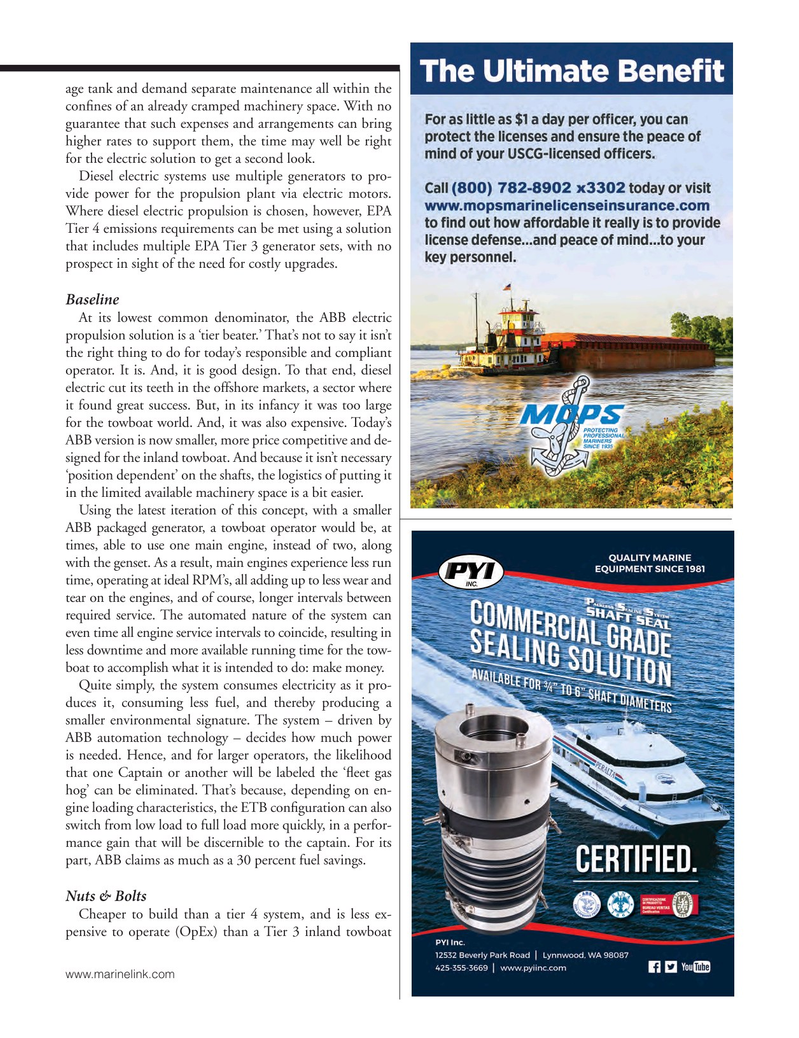
Page 41: of Marine News Magazine (July 2018)
Propulsion Technology
Read this page in Pdf, Flash or Html5 edition of July 2018 Marine News Magazine
age tank and demand separate maintenance all within the con? nes of an already cramped machinery space. With no guarantee that such expenses and arrangements can bring higher rates to support them, the time may well be right for the electric solution to get a second look.
Diesel electric systems use multiple generators to pro- vide power for the propulsion plant via electric motors.
Where diesel electric propulsion is chosen, however, EPA
Tier 4 emissions requirements can be met using a solution that includes multiple EPA Tier 3 generator sets, with no prospect in sight of the need for costly upgrades.
Baseline
At its lowest common denominator, the ABB electric propulsion solution is a ‘tier beater.’ That’s not to say it isn’t the right thing to do for today’s responsible and compliant operator. It is. And, it is good design. To that end, diesel electric cut its teeth in the offshore markets, a sector where it found great success. But, in its infancy it was too large for the towboat world. And, it was also expensive. Today’s
ABB version is now smaller, more price competitive and de- signed for the inland towboat. And because it isn’t necessary ‘position dependent’ on the shafts, the logistics of putting it in the limited available machinery space is a bit easier.
Using the latest iteration of this concept, with a smaller
ABB packaged generator, a towboat operator would be, at times, able to use one main engine, instead of two, along with the genset. As a result, main engines experience less run time, operating at ideal RPM’s, all adding up to less wear and tear on the engines, and of course, longer intervals between required service. The automated nature of the system can even time all engine service intervals to coincide, resulting in less downtime and more available running time for the tow- boat to accomplish what it is intended to do: make money.
Quite simply, the system consumes electricity as it pro- duces it, consuming less fuel, and thereby producing a smaller environmental signature. The system – driven by
ABB automation technology – decides how much power is needed. Hence, and for larger operators, the likelihood that one Captain or another will be labeled the ‘? eet gas hog’ can be eliminated. That’s because, depending on en- gine loading characteristics, the ETB con? guration can also switch from low load to full load more quickly, in a perfor- mance gain that will be discernible to the captain. For its part, ABB claims as much as a 30 percent fuel savings.
Nuts & Bolts
Cheaper to build than a tier 4 system, and is less ex- pensive to operate (OpEx) than a Tier 3 inland towboat www.marinelink.com
MN July18 Layout 32-49.indd 41 MN July18 Layout 32-49.indd 41 6/20/2018 10:59:20 AM6/20/2018 10:59:20 AM

 40
40

 42
42
